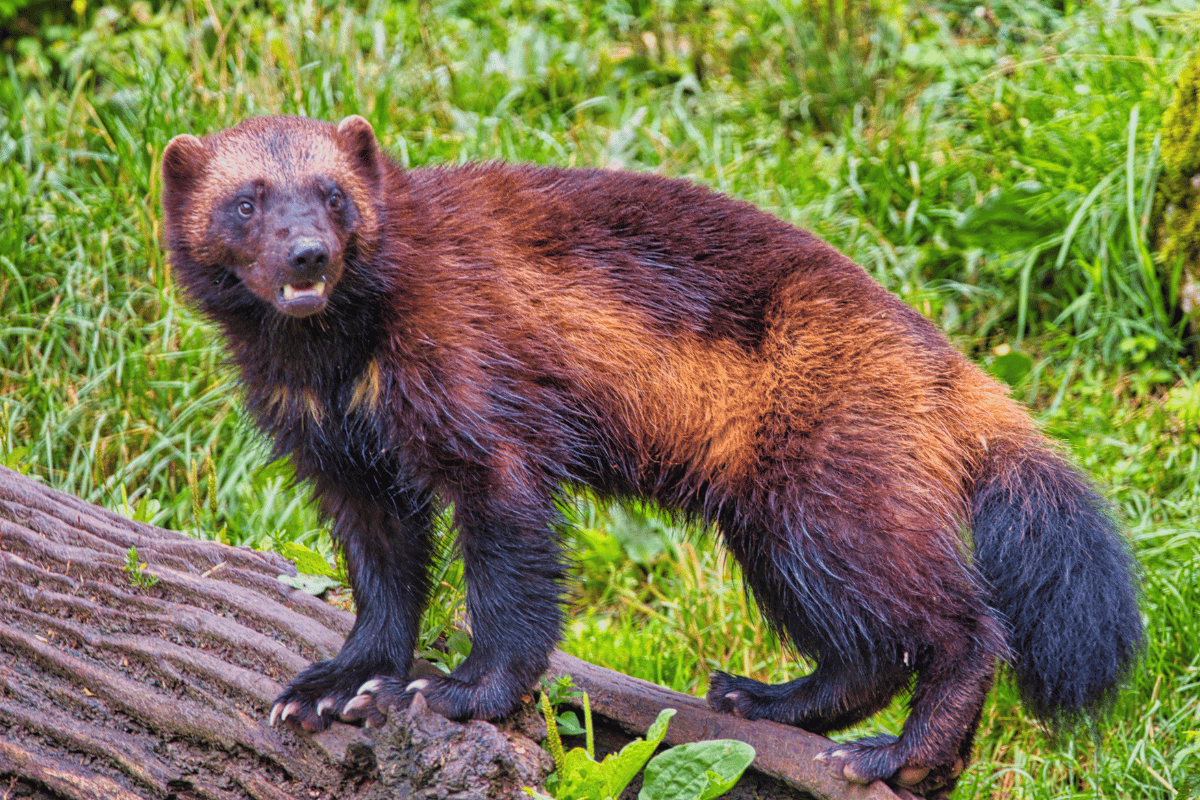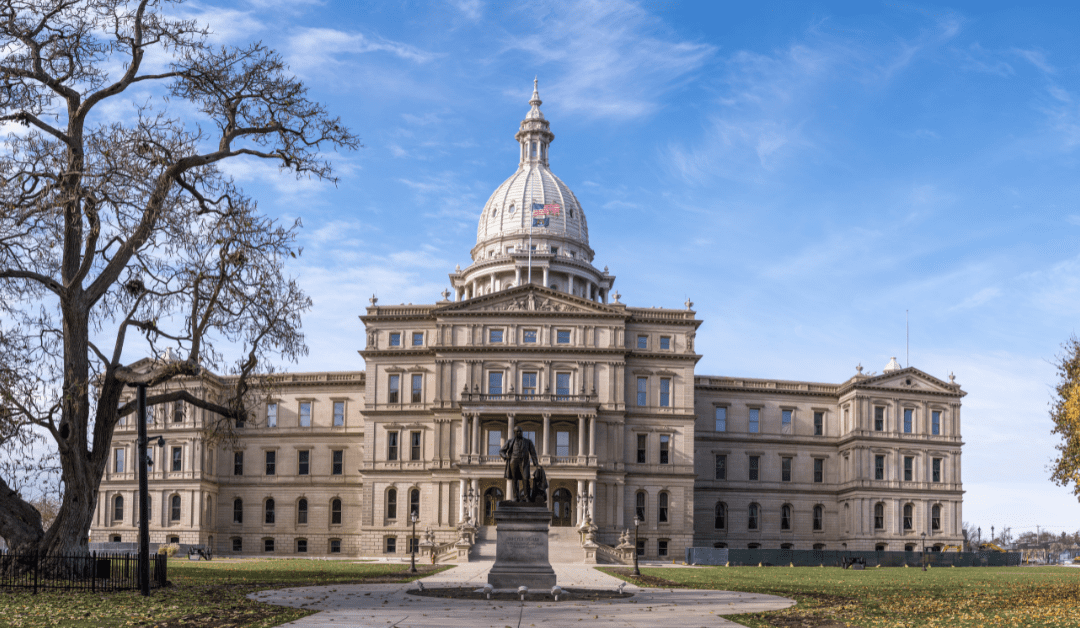
(Image via Canva)
How did Michigan become tied to an animal that’s practically nonexistent there?
Among the many nicknames that the state of Michigan has, arguably none is as curious as the “Wolverine State.” The animal is, after all, exceedingly rare in Michigan—the last wild wolverine was spotted in the state two decades ago.
So, how is it that an animal that barely exists here became so tied to our state? Let’s investigate.
What’s the deal with Wolverines in Michigan?

A wolverine is pictured on a rock. (Photo courtesy of US Fish & Wildlife Service)
If you’re not that familiar with wolverines, they are the largest land-dwelling members of the Mustelidae family—which includes weasels, badgers, and otters. In essence, think of them as giant weasels.
However, what sets the wolverine apart from its cousins is its fierce reputation. Although primarily scavengers—and only growing to be about 25 pounds—they are known to be ferocious enough to fight off animals many times their size, like bears and wolves.
They once ranged across the northern and western United States, but their known habitat is now limited to northern Canada, Idaho, and Alaska.
For many years, the last confirmed sighting of wolverines in Michigan had been in the late 1700s and early 1800s by fur traders. Up until the late 1990s, the state had the wolverine on its endangered species list, but officials removed it once it was determined it wasn’t likely to return. Experts believe Michigan likely hasn’t housed a breeding population of the species for 200 years.
In 2023, the US Fish and Wildlife Service officially declared the wolverine endangered in the lower 48 states of the US, with only an estimated 250-300 wolverines still living in the area.
A spectacular sighting
Wildlife biologist Arnie Karr was able to photograph a wolverine as it ran out of the woods and across a field in 2004. (Photo courtesy of Arnie Karr / DNR via AP)
In February of 2004, something spectacular was documented: photographic evidence of a wild wolverine in Michigan.
Following reported sightings by coyote hunters in the Thumb area, Michigan Department of Natural Resources wildlife biologist Arnie Karr was able to snap photos of a wolverine as it walked across a field. For the DNR, the sighting was unprecedented, with a spokesperson saying it was “up there with having a caribou or a polar bear turn up.”
The wolverine continued living in the area for the next several years, even being spotted on a local’s trail cam.
Sadly, hikers discovered the body of the wolverine in 2010 in the Minden City State Game Area.
There is still a lot of speculation as to how the wolverine ended up in the Thumb—the next closest documented wolverine was 100 miles north in Canada—but Karr believes it was someone’s exotic pet that was released into the wild. Another theory is that the wolverine caught a ride on a Canadian garbage truck before it made its way to a Michigan landfill.
The state has since preserved the wolverine. Its final home is at the Jennison Exhibit Hall at the Saginaw Bay Visitor Center.

The preserved female wolverine is now displayed at the Saginaw Bay Visitor Center. (Photo courtesy of Michigan Department of Natural Resources)
Why ‘Wolverine State?’
It’s no secret at this point that the wolverine is an incredibly elusive animal, so it probably shouldn’t come as a surprise that the origins of Michigan being called the “Wolverine State” are just as mysterious.
There is no concrete answer that everyone agrees on for the moniker, but there are several theories.
According to geographer Randall Schaetzl at Michigan State University, the wolverine was disliked by Michigan’s Native American population. So, when Americans began colonizing the territory in the early 1800s, tribespeople began to refer to Americans as Wolverines because it was “the worst thing they could call them.”
Another theory—and my personal favorite—traces the name back to the Toledo War. We’ve covered that event extensively in this newsletter, but as a quick refresher, essentially, it was a short war between the territory of Michigan and the state of Ohio for a small strip of land that included the city of Toledo. During the brief skirmish, however, rumors began to spread in Ohio of the viciousness of the Michiganders, who were as bloodthirsty as wolverines. In the end, Ohio ended up keeping Toledo, but Michigan got the Upper Peninsula when it became a state.

An undated newspaper clipping that describes people from the Wolverine State as greedy, ugly, and sour. (Photo courtesy of project.geo.msu.edu)
A third theory ties the name to Michigan’s trading roots. During the fur-trading heyday, wolverine pelts would regularly make their way from Canada and through Michigan, with the name “Sault Ste. Marie, Michigan,” often attached to the shipping labels. Over time, wolverines became more closely associated with Michigan than Canada as a result.
Whatever the true case may be, the name stuck quick. Students at the University of Michigan began referring to themselves as Wolverines as early as 1861.
Although it might be another hundred years before another wild wolverine is spotted in Michigan, there is another way to see a live one in the state. The Detroit Zoo has a breeding pair of wolverines in its American Grasslands exhibit.
Politics

Slotkin urges Michiganders to compare prices before buying prescription drugs
A law sponsored by Congresswoman Elissa Slotkin is helping patients compare prices for different prescription drugs at different pharmacies—saving...

‘Melody’s Law’ would explicitly criminalize necrophilia in Michigan
BY ANNA LIZ NICHOLS, MICHIGAN ADVANCE MICHIGAN—There is no law on the books in Michigan that expressly criminalizes engaging in sexual conduct with...

SEIU workers ahead of NFL Draft: We are ‘the backbone of Detroit’
BY KEN COLEMAN, MICHIGAN ADVANCE MICHIGAN—A day ahead of the National Football League annual draft being held in Detroit, Service Employees...
Local News

The 9 best pizzas in Michigan, according to our research
When it comes to finding the best pizza in Michigan, the options are endless. From the bustling city of Detroit to the quaint town of Cadillac,...

Lions trade up in first round of NFL draft, take Alabama cornerback Terrion Arnold
ALLEN PARK—The Detroit Lions made a move to address their secondary, grabbing Alabama cornerback Terrion Arnold with the No. 24 pick in the NFL...






